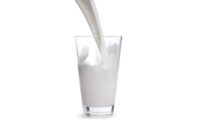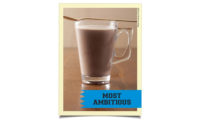In searching for signs of life in the fluid milk category, one can find a pulse. Sales of whole milk rose 4.1% from 2014 to 2015. Sales also increased for 1% milk (4.6%), whole flavored milk (6.4%), other flavored milk (1.3%) and buttermilk (5.2%). These segments represent opportunities for fluid milk processors.
Milk | Cheese | Cultured | Ice Cream | Butter | Non-dairy Beverages | Ingredients | Exports
But at the end of the day, sales of all fluid milk products in 2015 were down 1.4% from 2014, according to the U.S. Department of Agriculture. Still, the good news here is that the rate of change had slowed. By way of comparison, milk sales dropped nearly 3% from 2013 to 2014.
What is helping the fluid milk industry succeed are specialty milks, limited-time offers, new coffee-milk hybrids and industry marketing. Drinkable yogurts, though not included in the USDA figures, represent another way to process milk. Sales of drinkable yogurt are expected to grow 11% in 2016, making this the second straight year of double-digit gains, according to Mintel, a Chicago-based research firm. (Read more on page 36.)
Simple actions, like getting back to basics (selling harder and opening new accounts), also helps.
“Milk sales are tough because it’s a commodity-based business,” said Steve Feldkamp, executive vice president and chief operating officer Umpqua Dairy Products, Roseburg, Ore. “The only way to grow milk sales is by expanding our distribution. We’ve been able to grow along with our customers.”
Umpqua’s sales have grown because retailers have added stores and new chains, such as Dollar General, have entered the Pacific Northwest, he said. “We are going to have to do the hard work, to do the sales calls and prove ourselves again and again.”
As the accompanying tables show, specialty products like organic whole milk and lactose-free milks posted double-digit or near double-digit gains in the 52 weeks ended Sept. 4, 2015, according to Chicago-based market research firm Information Resources Inc. Unit sales rose 9.8% for Horizon Organic (by WhiteWave), 10.9% for Organic Valley and 15.1% for Hood Lactaid. Unit sales of high-protein, reduced-fat milk from fairlife rose more than 200%. Sales increased for every brand in the top 10 in the flavored milk segment (which includes egg nog and buttermilk) except for Borden (down 5.4%) and Horizon Organic (down 3%).
Iced coffee beverages made with milk have proven to be a boon for fluid milk processors. Unit sales increased 13% in the last year, according to IRI. Dean Foods Co., the nation’s largest milk processor, has Caribou ready-to-drink ice coffee in three flavors: sea salt caramel, chocolate mocha and vanilla. Launched in June, the drink is packaged in 14-ounce and 32-ounce bottles.
Cold-brew coffee is a popular drink, especially with the millennial generation, according to Shamrock Farms. Coffee grounds are steeped in cold water for 10 hours or longer. In September Shamrock Farms released its Cold Brew Coffee and Milk, which combines 100% Colombian coffee with milk.
Smith Brothers Farms, a small dairy in Kent, Wash., (and this magazine’s 2014 Plant of the Year), has a cold-brew organic coffee made in partnership with Tony’s Coffee, a local business.
Coffee is just one beverage to blend with milk. Dairy Farmers of America tried its hand this year with milk-based energy drinks. The Missouri-based dairy cooperative rolled out three flavors containing 46% fruit juice under its new Live Real Farms brand. The flavor combinations are strawberry/banana, peach/mango and berry blend. The dairy co-op states the energy comes from including Vitamin B12, fruit juice and green tea extract.
Limited-time offer flavored milks spur sales. Hiland Dairy, a unit of Illinois-based Prairie Farms, regularly releases seasonal flavors, including Peeps (named for the yellow marshmallow candy). This summer’s new flavor was Honey Cookie. Other flavors this year are salted caramel and chocolate and peanut butter, sold in pint bottles.
WhiteWave Foods, Broomfield, Colo., created the Sir Bananas brand of flavored milk. It sells half-gallons of banana and banana-cocoa flavored reduced-fat milk in select markets. The product will be available nationally in 2017, said Lauren Tankersley, director of Sir Bananas.
Egg nog is the original limited-time offer flavored milk, and dairy processors are straying far from the original nutmeg flavor. For the 2016 holiday season, Seattle-based Darigold introduced vanilla caramel eggnog. Umpqua Dairy developed a peppermint flavor for the upcoming holidays.
Besides flavor, milk processors are focusing on nutrition, especially protein. Nestle USA, the nation’s largest dairy processor, developed a high-protein version of its Nesquik brand of flavored milk. A 14-ounce serving of Protein Plus contains 23 grams of protein. It’s sold in chocolate and vanilla flavors.
WhiteWave’s Horizon also released a high-protein flavored milk this year. The organic milk contains 15 grams of protein in a 10-ounce single-serve package.
Other value-added products include organic milk and lactose-free milk. Dallas-based Dean Foods Co. in May introduced a lactose-free milk under its DairyPure brand. The dairy cited figures from the National Institute of Diabetes and Digestive and Kidney Diseases estimating that 30 to 50 million Americans are lactose-intolerant. Horizon this year also started making organic lactose-free milk in half-gallons.
Hiland Dairy, a processor of conventional milk, added organic milk options this year. The farmer-owned dairy cooperative packages milk in half-gallon and gallon sizes.
Milk processors are cleaning up their ingredient decks. Sir Bananas, for example, has no high-fructose corn syrup, carrageenan, artificial flavors, sweeteners or colors. Dean Foods’ DairyPure milk makes a Five-Point Purity Promise, one of which is that the milk contains no artificial growth hormones. And Horizon Organic Brand Manager Brittney Polka noted that Protein Plus chocolate milk also is free of artificial colors, flavors and preservatives.
One of the biggest announcements this fall related to clean labels came from Clover Stornetta Farms. The third-generation family-owned and -operated dairy in Petaluma, Calif., said it is committed to converting its conventional milk products to be Non-GMO Project Verified over the next two years.
In a statement, Clover President and CEO Marcus Benedetti said, “Our focus on non-GMO reaffirms our commitment to invest in the future of our dairy cows, family farms and communities. Our hope is to lead the way by creating an industry-wide movement towards more non-GMO feed options for our dairy cows. We look forward to working closely with our dairy partners to make this goal a reality.”
With the exception of Dean Food’s DairyPure, there isn’t a national milk brand with the wherewithal to invest heavily in milk advertising and promotion. The Milk Processor Education Program, funded by milk processors, plays that role. The Washington, D.C.-based checkoff program engineered a multiyear partnership with the U.S. Olympic Committee. Sixty brands participated in the Summer Olympics, either by designing special packaging with the Olympic rings, buying advertising or using social media. MilkPEP’s YouTube content generated 3 million views, said MilkPEP CEO Julia Kadison.
Kadison called the Olympics a “critical part of our long-term strategy.” But that’s not the only part. There is a campaign (My Morning Protein) that encourages consumers to pair milk with other high-protein foods at breakfast, such as eggs. Built With Chocolate Milk shows how the beverage helps athletes recover after strenuous workouts. BWCM sponsors the Rock n Roll Marathon series and USA Swimming.
Its Great American Milk Drive has resulted in donations of nearly 1 million gallons to food pantries (delivered as packages or as vouchers). An ancillary benefit of the milk drive, Kadison noted, is that the program also spurs sales. As mothers see point-of-sale materials touting milk’s nutrition, they decide to buy milk for their own families, she said.
MilkPEP also is using research to show retailers the opportunities in the dairy aisle. MilkPEP found, for example, that milk generates 18% of dairy department profit from only 10% of the space, and shopping carts with milk are 23% more profitable than those without.
Doug Adams, president of Prime Consulting, Northbrook, Ill, conducted some of the research MilkPEP cites. He shared some of the findings in a Dairy Foods webinar in September. (Listen to it at webinars.dairyfoods.com.)
Dairy processors have to make sure their products are in the right spot in a supermarket. Besides being in the traditional dairy case, milk needs to be in the front of the store in grab-and-go cases, said Adams. Additional placement in a store might take a second sales call, he observed, because the milk buyer is not making the decision for the single-serve case. It’s probably a deli manager or a restaurant manager.
Supermarket turf battles over which department gets credit for the sale mean that dairies might consider creating separate UPCs or unique items for products sold in grab-and-go cases. Or, they should consider not placing single-serve products in the main milk case. This would help supermarket managers know which department was responsible for the sale, Adams said.
Kadison said MilkPEP’s four-part, three-year strategy consists of maximizing the Olympic partnership; keeping milk “top of mind” with moms to serve to their children; align with food culture and help build brands. Aligning with food culture includes being close to nature, farm fresh and local, she said. The millennial generation is identified with these attitudes.
A newly completed research project sought to understand moms, children and their relationship with milk.
“Kids love milk. They have this passion for milk that we think we can really leverage,” she said. But children are drinking water and plant-based milk alternatives. In all, the dairy industry has lost one-half billion gallons of milk. “We have to win it back,” she said.
Conclusion
Dairy executives are confident about their ability to increase sales. Horizon Organic’s Polka said “the growing demand for organic foods, especially organic dairy products, makes us optimistic about the future of organic dairy in 2017.”
“Darigold is optimistic about the continued growth opportunities for U.S. dairy products. Dairy is on a good trend,” said CEO Stan Ryan. “It’s the most affordable protein source. Butter and cheese are healthy foods to eat. The category is growing and full of innovation.”
Gary Aggus, chief operating officer and president of farmer-owned Hiland Dairy said, “the milk industry as a whole is united in communicating dairy’s benefits. Alignment with high-profile programs, like the Olympics, has brought greater consumer awareness of dairy’s importance to overall health and well-being. We remain highly optimistic because Hiland Dairy provides a wholesome, healthy and local product that consumers want and need.”
What’s the industry talking about?
- Adding value
- Coffee and dairy blends
- Juice and dairy blends
- Popularity of drinkable yogurts
- Protein content
- Sponsorship of the U.S. Olympics
- Whole milk sales grow
- Marketing limited-time offers
Milk | Cheese | Cultured | Ice Cream | Butter | Non-dairy Beverages | Ingredients | Exports











